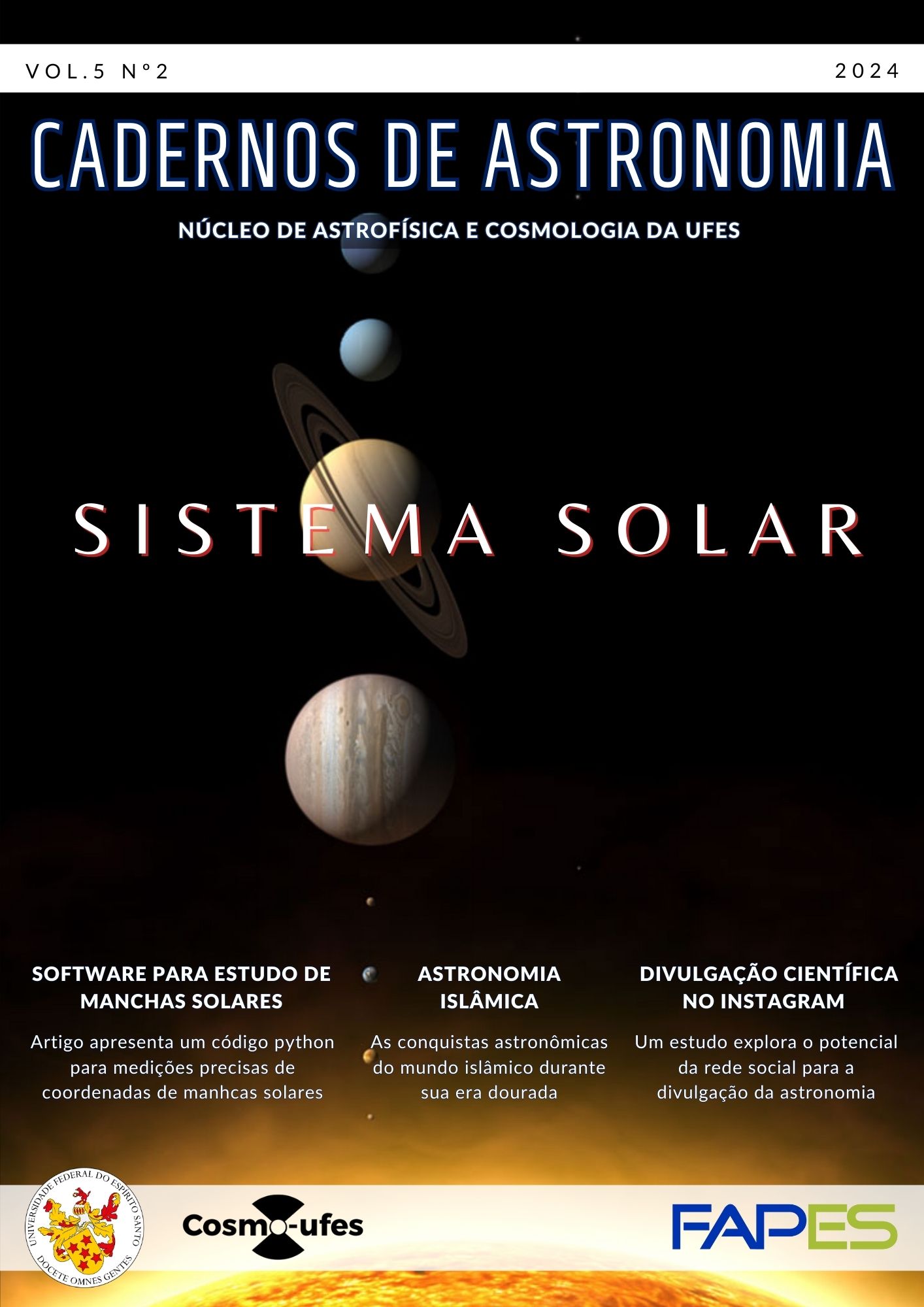Achatamento rotacional dos planetas
DOI:
https://doi.org/10.47456/Cad.Astro.v5n2.44870Palavras-chave:
achatamento dos planetas, achatamento rotacional, sistema solarResumo
Corpos celestes em rotação não possuem simetria esférica, pois a gravidade efetiva é menor no equador do que nos polos. A deformação depende não somente da velocidade de rotação mas também da estrutura interna do corpo. Neste artigo, a deformação ou “achatamento” dos planetas do sistema solar, devido a rotação dos mesmos, é estimada modelizando tais corpos como um “fluido” ou como um corpo “elástico”. A comparação com as observações permite obter informações sobre a estrutura interna.
Referências
I. Newton, Natural philosophy and the principles of mathematics (University of California Press, 1966).
P. L. M. de Maupertius, La figure de la Terre determinée (Académie des Sciences, 1739).
A. Love, Some problems of geodynamics being an essay to which the Adams prize in the University of Cambridge was adjusted in 1911 (Cambridge University Press, 1963).
A. Love, A treatise on the mathematical theory of elasticity (Cambridge University Press, 1892).
L. Landau e E. M. Lifshitz, Theory of elasticity (Oxford, 1959).
O. D. Kellogg, Foundations of potential theory, vol. 31 (Springer Science & Business Media, 2012). Disponível em http://eudml.org/doc/203661, acesso em ago. 2024.
M. Lecar, J. Sorenson e A. R. Eckels, A determination of the coefficient J of the second harmonic in the Earth’s gravitational potential from the orbit of satellite 1958 β2, Journal of Geophysical Research 64, 209 (1959), uma fórmula para o avanço do argumento do perigeu é dada como um exercício resolvido no livro “Mécanique” de L. Landau e E. M. Lifshitz, Editions de la Paix, Moscou (em francês).
B. Berche e E. Medina, The advance of Mercury’s perihelion (2024). ArXiv:2402.04643.
C. Brans e R. H. Dicke, Mach’s Principle and a Relativistic Theory of Gravitation, Physical Review 124(3), 925 (1961).
C. Damiani et al., A brief history of the solar oblateness. A review, Journal of Atmospheric and Solar-Terrestrial Physics 73(2–3), 241 (2011).
A. C. M. Correia e A. Rodríguez, On the equilibrium figure of close-in planets and satellites, The Astrophysical Journal 767(2), 128 (2013).
S. J. Peale, The gravitational fields of the major planets, Space Science Reviews 14(3–4), 412 (1973).
C. F. Yoder, Astrometric and Geodetic Properties of Earth and the Solar System, in Global Earth Physics: A Handbook of Physical Constants, volume 1 (American Geophysical Union, 1995), 1–31.
B. Wang et al., The Neptunian gravity estimated from the motion of Triton based on astrometric observations, Astronomy and Astrophysics 671, A70 (2023).
B. A. Neuenschwander e R. Helled, Empirical Structure Models of Uranus and Neptune, Monthly Notices of the Royal Astronomical Society 512(3), 3124 (2022). ArXiv: 2203.02233.
L. Iess et al., Measurement and implications of Saturn’s gravity field and ring mass, Science 364, eaat2965 (2019).
D. Kong, K. Zhang e G. Schubert, On the interpretation of the equatorially antisymmetric Jovian gravitational field, Monthly Notices of the Royal Astronomical Society (2017).
J. A. F. Pacheco, Vida no universo (Edusp, São Paulo, 2020), ver capítulo 2 - Formação do Sistema Solar, p. 55.
M. Marder e J. Fineberg, How Things Break, Physics Today 49(9), 24 (1996).
I. de Pater e J. J. Lissauer, Planetary Sciences (Cambridge University Press, Cambridge, 2010), second ed.
S. Vincent e J. A. de Freitas Pacheco, Axisymmetric Oscillations of Rotating Neutron Stars: Gravitational Wave Emission, in Pulsar Astronomy: Unrevealing Compact Stars with China’s New Facilities, editado por J. H. Z. Gao, R. Xu e C. Vasconcellos (World Scientific, Singapore, 2024).
Downloads
Publicado
Edição
Seção
Licença
Copyright (c) 2024 J. A. de Freitas Pacheco

Este trabalho está licenciado sob uma licença Creative Commons Attribution 4.0 International License.






